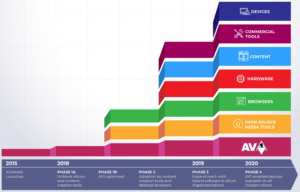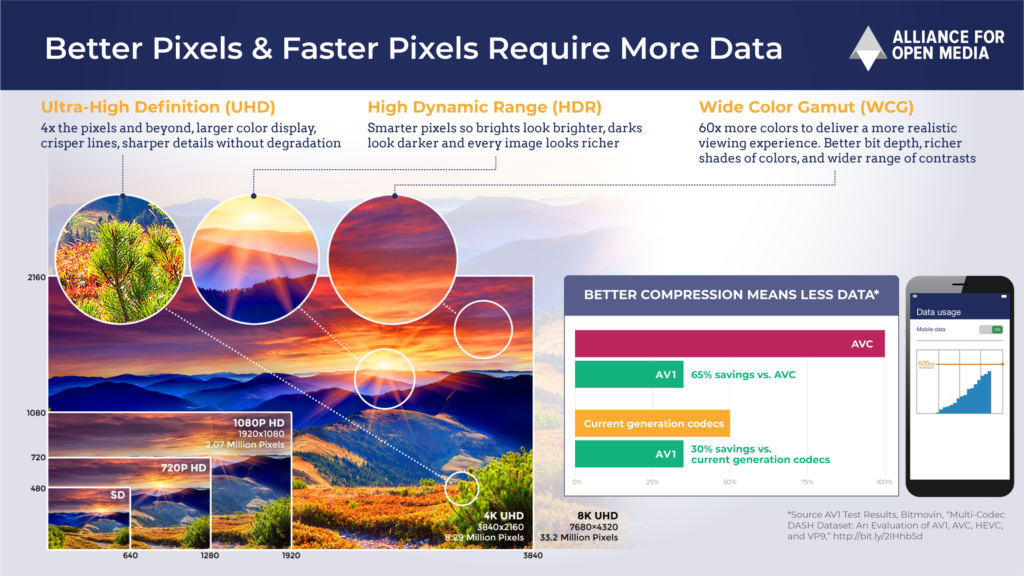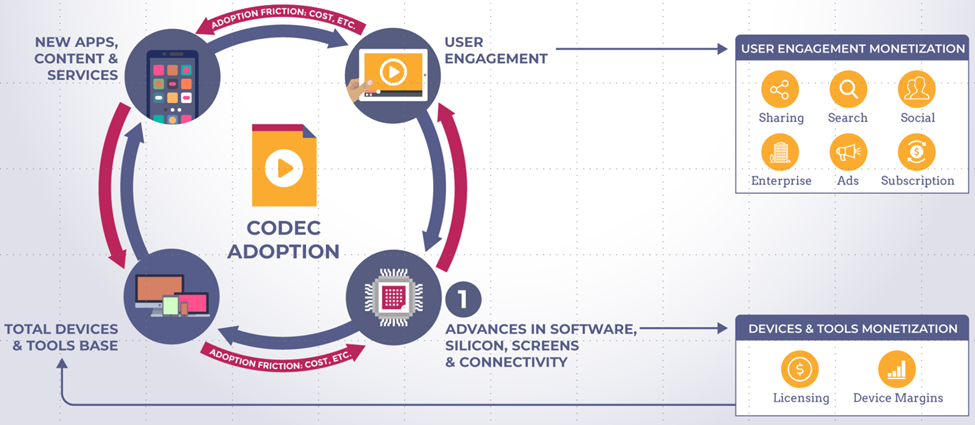Open and free with lots of backers
The Alliance for Open Media (AOMedia) formed in September 2015, with the goal of developing a royalty-free, open-source video format as an alternative to fee-based formats such as H.264 and HEVC. At the time, the Alliance’s initial seven Founding Members—Amazon, Cisco, Google, Intel, Microsoft, Mozilla, and Netflix set out to advance video codec technology through their first project, AOMedia Video (AV1), and to create a royalty-free ecosystem for that technology to thrive. They believed that that market demand for video innovation was hindered by uncertainty stemming from licensing practices of incumbent technologies, and that settling patent licensing terms up front combined with broad and transparent collaboration would fix these challenges, helping usher in the next generation of video-oriented experiences.
At the time, others in the industry were also dealing with their own challenges. The W3C did not put a video format in the specification for HTML5, because of the lack of a suitable video format that would work on the free and open web. Failed negotiations for one mandatory video format for WebRTC showed a broader need for a competitive open video standard. Also, the emergence of a second patent pool for HEVC (HEVC Advance) in Spring 2015 provided motivation for investments in an alternative video format and helped spur support for the Alliance as the new patent pool spread uncertainty regarding royalties for MPEG’s next-generation video format.
Today, the Alliance has more than 35 members with a large collective base of essential video patents licensed royalty-free for use with AV1 and a broader open source community. AOMedia’s Founding Members have grown to include Amazon, Apple, ARM, Cisco, Facebook, Google, IBM, Intel, Microsoft, Mozilla, Netflix, and NVIDIA. The AV1 codec has taken a little longer than the consortium thought but the spec is finished, and AV1 is ready.

The codec is ready to go, and not a moment too soon. With the emergence of 4K UHD (and soon 8K) cameras and screens in TVs and computer monitors, along with super wide color gamut (WCG) and high dynamic range (HDR), the amount of data that is being pushed around for images, still and moving, is enormous and increasing every day.
Phase 1: Desktop browsers support AV1 playback on capable devices using software that is not yet capable of hardware offload. In preparation for hardware support, general-purpose operating systems define a graphics driver interface to enable graphics processing unit (GPU) or discrete hardware offload.
Phase 2: Open source media tools and frameworks support AV1, which are the basis for popular applications and video encoding tools. As a result, a new generation of video content creation begins. User-generated video streaming services start to prefer AV1 for increased quality on capable devices. Communications applications such as messaging, video chat, and video sharing tools begin to prefer AV1 to increase video quality for a longer-tail of customers on capable devices.
Phase 3: Current generation game consoles support playback of this new AV1 content using software that has optimizations to leverage a GPU for partial acceleration. The next-generation of silicon used by new computers, laptops, tablets, mobile, television and set-top-box devices support AV1 playback at higher resolutions and frame rates using a hybrid combination of hardware and optimized software. Commercial video tools differentiate AV1 with higher levels of optimization and efficiency for creating large libraries at scale. Capable mobile devices begin to offer AV1 for capturing and sharing video.
Phase 4: All new consumer devices support AV1 playback, camera capture, and real-time communications.

AOMedia claims that in general AV1 offers 30% better compression.
AV1 is not just about more pixels but pixels that will take advantage of the resources in modern screens and hardware which will bring brighter whites, darker blacks and a richer gamut of colors. By eliminating problems such as color bands, screens will display much more vivid pictures with more details—cinema-like quality. Typically, the size of the video data increases dramatically as you move from HD to UHD and add in WCG and HDR. With AV1, the Alliance aims to further reduce the video size by 30% or higher than alternatives, according to independent tests.
Everyone seems to agree that much of the content that will be traversing the internet of the future will be video and a majority of devices connecting to those global IP are networks are mobile. Therefore, due to cellular connectivity, compression ratio really matters. On the other end of the spectrum, for consumers that live in highly dense areas, compression really matters there as well. Often a lack of bandwidth connectivity is needed to get HD. In these areas, AV1 compression algorithms are more efficient with how they send those HD video bits over the wire.

The backers of AOMedia is a list of who’s who in the industry, with some notable and not surprising absences AV1 is open-source and royalty-free—like the world wide web. As such it removes the innovation and adoption stumbling blocks of previous royalty-bearing technologies developed during the optical disc-era. By improving the compression rates over previous alternatives. AV1 aims to keep users from running out of storage space or your data plan from pushing past monthly limits.
- Codec developers—Cisco (Thor) Google (VPX), Mozilla (Daala), Microsoft (VC-1)
- Browser developers—Google (Chrome), Mozilla (Firefox), Microsoft (Edge) and more
- Content providers—Amazon (Prime), Facebook, Google (YouTube), Netflix, Hulu
- Hardware manufacturers—AMD (CPUs, GPUs, SoCs), Arm (SoCs), Intel (CPUs, GPUs, SoCs), Nvidia (GPUs)
- Operating system/device vendors—Cisco, Apple, Google (Android), Microsoft (Windows)
- OTT/RTC providers—Adobe, Amazon, Apple, Cisco, Google, Facebook, Hulu, IBM, Netflix, etc.
And it already has wide-ranging and rapid acceptance from its members looking to drive new video streaming and conferencing experiences across more devices and services:
What do we think?
Will AOMedia prevent another VHS vs. Betamax or Blu-Ray vs. HD-DVD format war?
It may not prevent another standards war, but it likely will make it shorter and less damaging to consumers. There is still a group of patent holders who feel the investment they’ve made in developing their technology is valuable, unique, and represents a sunk cost they would like to get a return on. It was those companies that drove the AOM to form because the fees and T&Cs of the license was holding back advancement in the industry and only favoring a small group of companies.
There are other open source royalty free organizations, Khronos being one of them, the open software alliance, and LibreOffice are others. They have done wonders for enabling the industry and leveraging the contributions of individual companies. OAM is the right thing to do, its far from easy (tricky technology, administration, and liability protection issues) which is why their announcement is almost a year later than they had planned.
But it is only the first step. Now they have to convince hardware (think AMD, Intel, Nvidia, Qualcomm, etc.) and software application developers as well as infrastructure (think API and OS suppliers) to adopt and enable the codec. This never happens as fast as one would like, and then when it does it becomes part of the fabric of our systems and the utilization of them. Open standards always win, always.





